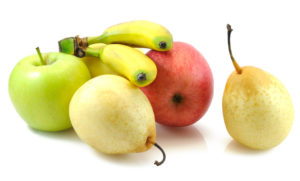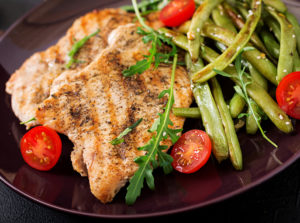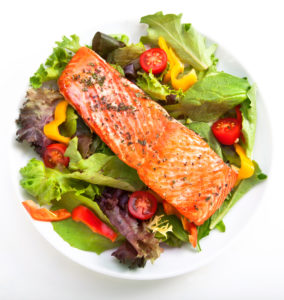3 Nutrients That May Help To Lower Triglycerides
Wondering how to lower triglycerides levels? The nutrients discussed here—per solid scientific backing—can work effectively to lower triglycerides naturally.
If you’ve discovered that you have high triglycerides, it’s important to learn how to lower your levels. How to lower triglycerides? A number of ways are available, but you almost always should begin by using three of the most-researched natural therapies: omega-3 fatty acids, fiber, and niacin, each of which we’ll discuss in more detail below.
First, a word on triglycerides in general. High cholesterol has received most of the attention from heart health experts for years. Recently, however, scientists have discovered that having high triglycerides is a much more significant indicator of cardiovascular disease than is total cholesterol. In fact, having high triglycerides can triple your risk of heart disease and stroke even if you have low cholesterol levels.[1]

This illustration shows the standards for normal vs. high triglycerides levels.
What Are Triglycerides?
Triglycerides are a type of fat found in your blood that are actually needed for good health. They are important because they provide your body with energy. But when triglyceride levels become too high, your body begins to store them as fat—and the risk of heart disease increases. So the first step is to learn how to lower triglycerides.
A simple blood test will determine your triglyceride level. Here are the triglyceride ranges, with units of measurements given in milligrams per deciliter (mg/dL):
- Normal is less than 150.
- Borderline-high is 150 to 199.
- High is 200 to 499.
- Extremely high is 500 or higher.
Diet Advice: How to Lower Triglycerides Naturally
So how can you lower triglycerides naturally? First, try eating your way to better heart health.
A healthy triglyceride diet should include a combination of foods with specific nutrients, including those that are rich in antioxidants, like cranberries. And until you learn how to lower triglycerides below 150 mg/dL, you may also want to augment your diet with nutritional supplements that provide therapeutic levels of these same nutrients. Drinking tea is another beneficial habit for reducing triglycerides.
Most important, make sure the following trio of key nutrients are in your diet.
1. Omega-3 fatty acids
A study published in the Journal of the American College of Nutrition concluded that omega-3 fatty acids can reduce triglycerides in patients with coronary artery disease (CAD).[2] Sardines, salmon, flax seeds, and walnuts are excellent food sources of omega-3 fatty acids.
However, most people do not eat enough of these foods to get the amount of omega-3s needed to reduce triglyceride levels. Therefore, supplementation is a key strategy for how to lower triglycerides. Your fish oil supplements should provide 1000 mg of the combined omega-3′s DHA (docosahexaenoic acid) and EPA (eicosapentaenoic acid) daily in order to achieve the recommended cardio-protective dosage.

Keep such fruits as apples, pears, and bananas in your diet to get enough fiber—and to lower triglycerides naturally.
2. Fiber
Studies show that low dietary fiber is common in a high-triglyceride diet.[3,4] So if that is a reflection of your cholesterol score, increased fiber intake is a must in lowering your triglycerides. The current recommendation for fiber is about 25 to 30 grams daily. Unfortunately, the average American eats about 10 to 12 grams of fiber each day. (No wonder we’re sick!)
Good sources of fiber include beans, oatmeal, apples, bananas, pears, greens, and sweet potatoes. (See also our post “Why Is Fiber Important? Lower Cholesterol, Prevent Disease, and Live Longer by Eating More Fiber.“)
Fiber can also be consumed in supplements but you should be careful to purchase supplements that do not contain laxatives or stimulants, as these can be harmful. Good sources of fiber include inulin and psyllium. Inulin is a prebiotic that can stimulate the growth of beneficial bacteria. Psyllium is a natural source of both soluble and insoluble fiber. For either of these products, it is best to follow the manufacturer’s dosing instructions and take the supplements with plenty of water.

You’ll find niacin in such food sources as turkey and chicken, not to mention tuna, salmon, and halibut.
3. Niacin
Niacin—vitamin B3—not only reduces triglycerides and LDL cholesterol, but also increases HDL (“good”) levels. Niacin works in the liver by affecting the production of blood fats. It is so well researched and the evidence for using it to treat high cholesterol is so strong that it has become an accepted mainstream treatment. As such, it’s recommended by the National Cholesterol Education Program[5], which is managed by the National Institutes of Health and its National Heart, Lung, and Blood Institute division.
Foods that contain niacin include chicken, tuna, beef, turkey, halibut, and salmon. As a supplement, most patients get the benefits they desire at a daily dosage between 250 mg to 2000 mg (2 grams). Since taking niacin can cause flushing, you should start off taking a small dose at around 250 mg per day and increase the dosage as tolerated. Observe your flushing reaction. Most of the time the flushing reaction will subside altogether or else be greatly reduced after one to two weeks of taking the supplement. Others can ramp up fairly quickly.
Be aware that stomach distress, itching, and headache are occasionally experienced by niacin users. If you have liver disease, ulcers (presently or in the past), or gout, you will especially want to work with your doctor in using niacin therapy.
Share Your Experience with Lowering Triglyceride Levels
Do you have any experience with how to lower triglyceride levels? What do you think is the best strategy for how to reduce triglyceride levels? Share your thoughts in the comments section below.
Originally published in 2012, this post is regularly updated.
[1] American Journal of Clinical Nutrition, Vol. 86: 943-49.
[2] Journal of the American College of Nutrition, 2006 Dec; Vol. 25, No. 6, 480-485.
[3] JAMA. 1996; 275:447–51.
[4] Mayo Clinic
[5] Fundam Clin Pharmacol. 2007 Nov;21 Suppl 2:5-6.
[6] PLoS One. 2012; 7(7): e41735.



 News Briefs February 2024
News Briefs February 2024  Savor the Sweet Potato
Savor the Sweet Potato  What Are the Dangers of Erythritol?
What Are the Dangers of Erythritol? 
How to lower triglycerides? Start by making sure your diet has enough omega-3 fatty acids (walnuts and flax seeds are great sources) along with fiber and niacin.
© Sarahgen | Dreamstime